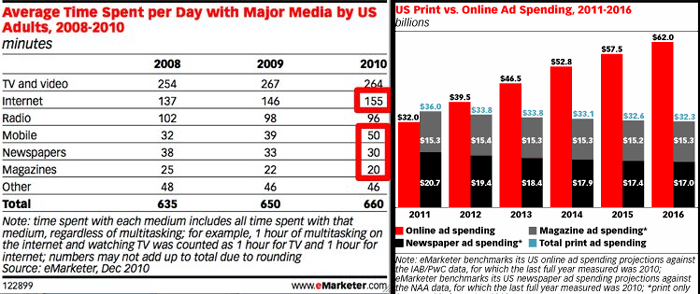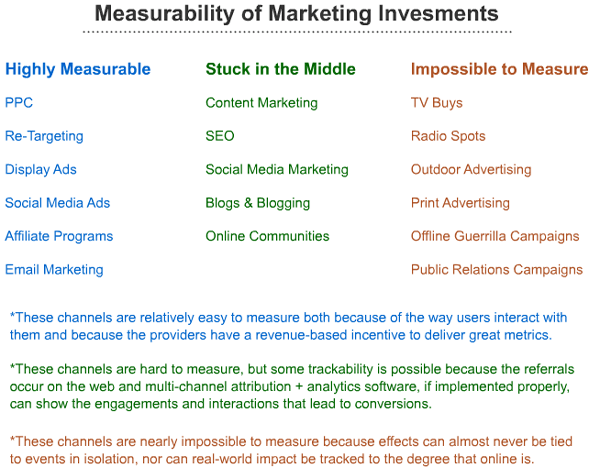When companies consider which marketing channels to invest in, data is almost always cited as the primary driver. In reality, just like everything else human beings do, biases and irrationality prevails.

In 2010, businesses could see that US consumption of print was less than 1/3rd the consumption of Internet content. And yet, even by 2016, eMarketer’s predicting that advertising spend will still be tilted in favor of this dying medium (though at least it’s directionally improving).
There’s probably a few biases happening here – the difference between the prestige of offline vs. online advertising, the long-term contracts and personal relationships of the print ad world, and the lag time it takes for marketing buyers to catch up with usage trends. But, I’d argue that a big, invisible one is measurability – and not in the way you’d think.
Logically, the more measurable a channel is, the more investment it should have (up to its relative maximum output level). In reality, channels that are on both ends of the measurability spectrum get a lot of investment, while those that are stuck in the middle, get marginalized.

Spending on PPC in the US (estimated by Forrester to be $22 billion in 2012) is likely 4-5X the investment on SEO in the US (at Moz, we’ve cobbled together a hodgepodge of sources and estimate ~$5 billion in 2012), yet traffic flowing to websites is 4-5X larger for SEO than PPC. This dichotomy likely has a lot to do with how relatively easy it is to invest in PPC as well as how easy it is to measure.
On the other end of the spectrum, brand sponsorship spending continues to be massive and completely unaccountable. The top 10 sponsorship advertisers ALONE spent ~$2 billion in 2011 (according to AdAge) on things like NFL stadium naming rights, the Olympic games, and to be the official such-and-such of so-and-so. The reason may be hard to swallow, but it has a perverse logic – if you can’t measure the ROI, you can’t criticize the ROI.
Even at SEOmoz, we make investments into untrackable marketing areas that we feel, in our gut, will have a positive impact on a marketing goal. We sponsor local meetups, host drinks at bars, attend conferences and events, and know that half the money and effort probably isn’t producing an ROI (though we intentionally invest in serendipity in many of these cases, too). But, we do invest very heavily in those “stuck in the middle” channels that are harder to measure, but not impossible. In fact, those are what built the company. Boris Wertz of Growlab wrote last week that there’s only 2 ways to build a $100mm business, but his post ignored the pursuit of stuck-in-the-middle channels, just as many companies have.
There are two reasons I love “stuck in the middle” marketing investments:
- Tough to measure means there’s a huge opportunity to be gained from getting good at that measuring difficulty and that future investments will gain efficiency and be more powerful if/when you get it right.
- Competition will be weak, because other marketers won’t overspend (like they do in unmeasurable channels) nor will they saturate like they do in easy-to-measure channels.
When it comes to marketing dollars, the road less traveled won’t just make all the difference. It will make lots of high-margin revenue, too.
